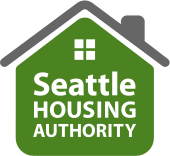SEATTLE—June 5, 2003—The SHA Board of Commissioners will consider a new rent policy for the Seattle Senior Housing Programat its June 16, 2003 Board meeting.
The rent policy, the product of SSHP Rent Structure Advisory Committee discussions, is designed to minimize impacts on current SSHP residents, ensure that 75 percent of SSHP units remain affordable to extremely low-income households and protect SSHP's long-term financial viability.
Today, about 86 percent of SSHP's 993 apartments are housing people with incomes below 30 percent of the area median income (AMI), currently $16,350 for a one-person household). SSHP tenants are charged 30 percent of their monthly income for rent.
This amount is often considerably lower than the cost to SHA of operating and maintaining the apartment. In most other low-income housing programs, subsidy is available to cover this gap. SSHP has no dedicated sources of outside subsidy, so it must meet all its expenses from rent revenues.
The new rent policy leads to a sustainable distribution of rents, as shown in the table below:
Area median income (AMI) |
Percent of units |
|
Less than 20% |
31% |
|
20 to 30% |
36% |
|
Housing Choice Vouchers |
15% |
|
30 to 40% |
14% |
|
40 to 80% |
4% |
This rent distribution creates enough rent revenue from higher income residents and Housing Choice Vouchers to cover the costs of housing residents with incomes below 30 percent of the area median.
The new tiered rent structure would price apartments within various affordability ranges. For example, an apartment with rent of $220 would be reserved for people earning less than 20 percent of median income. A different apartment would be rented for $350 and would be reserved for applicants with incomes up to 30 percent of median income. New residents will pay a rent that is affordable (i.e., around 30 percent but less than 40 percent of their income).
This structure will provide a predictable rent revenue stream for SHA, improve marketability of units, reduce administrative costs and minimize intrusion into residents’ lives associated with calculating rent as a percentage of income.
Other elements of the rent policy include:
-
A transition plan for current residents which keeps most residents' rents where they are, rather than requiring them to pay the flat, tiered rent for their income group.
-
An extra charge for two-bedroom units for new residents, unless required for disability accommodation or medical reasons.
-
A formula for annual rent increases based on the Social Security COLA for households with incomes at or below 30 percent of the area median, and the Consumer Price Index for households with higher incomes.
-
Creation of an ongoing advisory committee to review SSHP's performance and make recommendations to the Board of Commissioners.
-
Elimination of the asset limit on eligibility. Income from assets will still be included in determining a households' income for rent purposes.
The Committee considered and offered recommendations on many other issues that affect the rent policy including: the use of Housing Choice Vouchers in SSHP, the performance and marketability of SSHP buildings and units, and adjustments in management and maintenance that will reduce operating costs and allow rents to be kept low.
According to SHA Executive Director Harry Thomas, "We very much appreciate the committee members' hard work. I believe the current and future residents of SSHP will benefit greatly from the committee’s efforts to ensure that all points of view were aired, the complex issues examined in depth, and workable policy approaches developed to achieve our shared goals."
Members of the Rent Structure Advisory Committee included SSHP residents and representatives from the City’s Office of Housing and Human Services Division, the Seattle Displacement Coalition, the Northwest Justice Project and the Housing Development Consortium of Seattle and King County. Two SHA Commissioners—Marie Cook and Al Winston, Jr.—also served.
Public meetings
In May, SHA held four public meetings in SSHP buildings around Seattle to inform SSHP residents and others about the recommendation, answer their questions and solicit their comments. Altogether, about 100 residents attended these meetings.
Next steps
The new rent policy adopted by the Board will be implemented beginning on October 1, 2003, or as soon as possible thereafter. Some elements of the rent policy will be put in place a bit later; for example, rent increases based on Social Security COLA or CPI will wait until early 2004, when residents receive their COLA increases.
